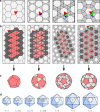Structural puzzles in virology solved with an overarching icosahedral design principle
- PMID: 31562316
- PMCID: PMC6765026
- DOI: 10.1038/s41467-019-12367-3
Structural puzzles in virology solved with an overarching icosahedral design principle
Abstract
Viruses have evolved protein containers with a wide spectrum of icosahedral architectures to protect their genetic material. The geometric constraints defining these container designs, and their implications for viral evolution, are open problems in virology. The principle of quasi-equivalence is currently used to predict virus architecture, but improved imaging techniques have revealed increasing numbers of viral outliers. We show that this theory is a special case of an overarching design principle for icosahedral, as well as octahedral, architectures that can be formulated in terms of the Archimedean lattices and their duals. These surface structures encompass different blueprints for capsids with the same number of structural proteins, as well as for capsid architectures formed from a combination of minor and major capsid proteins, and are recurrent within viral lineages. They also apply to other icosahedral structures in nature, and offer alternative designs for man-made materials and nanocontainers in bionanotechnology.
Conflict of interest statement
The authors declare no competing interests.
Figures





References
-
- Kroto HW, Heath JR, O’Brien SC, Curl RF, Smalley RE. C60: Buckminsterfullerene. Nature. 1985;318:262–163. doi: 10.1038/318162a0. - DOI
-
- Haeckel, E., Breidback, O., Hartmann, R. & Eibl-Eibesfeldt, I. Art Forms In Nature: The Prints Of Ernst Haeckel, 1st edn (Prestel, 2008).
-
- Fontana J, et al. Phage capsid-like structure of myxococcus xanthus encapsulin, a protein shell that stores iron. Microsc. Microanal. 2014;20:1244–1245. doi: 10.1017/S1431927614007958. - DOI
Publication types
MeSH terms
Substances
Grants and funding
LinkOut - more resources
Full Text Sources
Other Literature Sources

